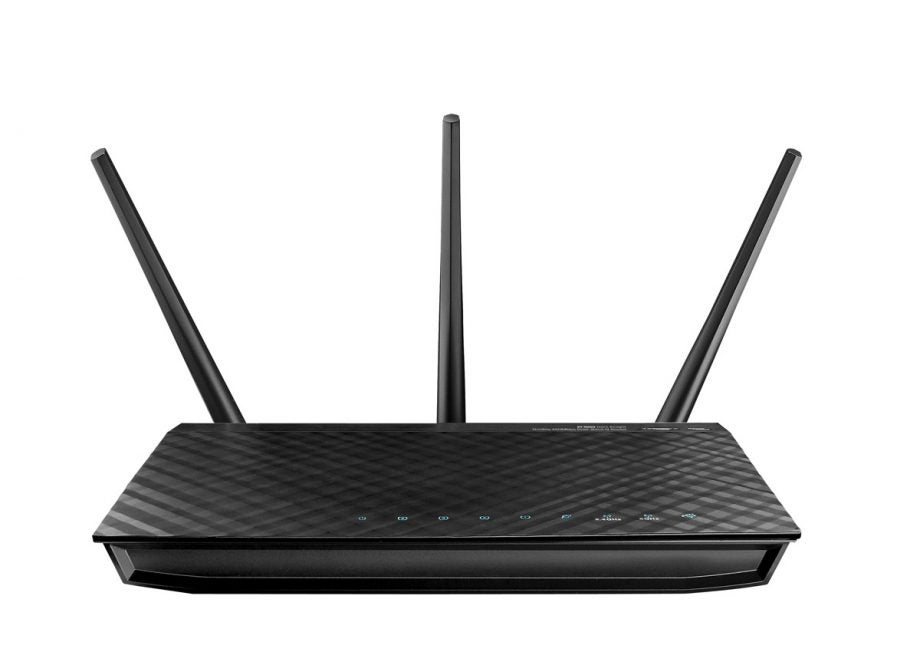Asus RT-AC66U 802.11ac router Review - Performance & Verdict Review
Performance & Verdict
Asus's first wireless 802.11ac router is very fast, but is that enough?

Sections
- Page 1 Asus RT-AC66U 802.11ac router Review
- Page 2 Performance & Verdict Review
Asus RT-AC66U – Performance
 So how does this fiesty looking router perform? Impressively. In our test environment of 2m and 10m line of sight and 13m between two standing walls, the AC66U clocked 802.11ac transfer speeds of 39.1MBps (312.8Mbit), 31.2MBps (249.6Mbit) and 27.8MBps (22.2Mbit).
So how does this fiesty looking router perform? Impressively. In our test environment of 2m and 10m line of sight and 13m between two standing walls, the AC66U clocked 802.11ac transfer speeds of 39.1MBps (312.8Mbit), 31.2MBps (249.6Mbit) and 27.8MBps (22.2Mbit).
The first of these is the fastest we have seen from any router, besting the 36.7MBps (293.6Mbit) achieved by the Linksys EA6700. As distance increases the EA6700 regains the lead with 35.2MBps (281.6Mbit) and 28.8MBps (230.4Mbit), but the AC66U remains the second fastest ac router we have tested, edging ahead of the D-Link DIR-868L.
It was a similar story with 5GHz wireless performance with the AC66U falling between the D-Link and Linksys. 2m, 10m and 13m speeds managed 21.1Mbit (168.8Mbit), 19.8MBps (158.4Mbit) and 11MBps (88Mbit), which makes it second to the Linksys at 2m and 10m, but much faster at 13m and faster than the D-Link at 2m and 10m, but slower than its remarkable 14.1MBps (112.8Mbit) at 13m.
 Interestingly – despite these excellent figures – the AC66U shines brightest at 2.4GHz 802.11n. It managed 11.6MBps (92.8Mbit), 10.6MBps (84.8Mbit) and 5.3MBps (42.4Mbit) at 2m, 10m and 13m respectively.
Interestingly – despite these excellent figures – the AC66U shines brightest at 2.4GHz 802.11n. It managed 11.6MBps (92.8Mbit), 10.6MBps (84.8Mbit) and 5.3MBps (42.4Mbit) at 2m, 10m and 13m respectively.
This makes it the fastest wireless ac router we’ve seen at 2.4GHz wireless n and much faster than the Linksys’ previous leading 13m benchmark of 3.3MBps (28Mbit).
In fact only the dedicated 802.11n D-Link DIR-845L can pip it at any distance with 5.5MBps (44Mbit) at 13m.
All of which means the AC66U won’t just bring you next generation speeds, it will significantly bolster speeds for your existing wireless n devices too.
As for performance via USB, like all other routers, it disappoints. The AC66U managed just 3.1MBps (24.8Mbit), which is a long way down on the USB 3.0 equipped Linksys EA6700 and D-Link DIR-868L [7.1MBps (56.8Mbit) and 4.9MBps (39.2Mbit) respectively] and it continues to show USB network sharing – while convenient – struggles badly compared to Gigabit Ethernet.
Why? While it differs from router to router, typically they lack enough memory to cache large amounts of USB data before firing it over their network. By contrast Ethernet is already part of the network and doesn’t need caching. 
Should I buy the Asus RT-AC66U?
Based on wireless performance alone the AC66U is well deserving of your attention as it tussles successfully in all wireless n/ac tests with the two fastest routers we have seen to date. At £159.99 it also splits both routers in price with the Linksys EA6700 dearer at £169.99 and the D-Link DIR-868L a bit cheaper at £139.99.
If you can afford it we would still give the EA6700 the edge, despite its ropey 5GHz wireless n performance at range. This is because its Smart WiFi platform remains a real benefit, offering complete control of the router from any location with an internet connection. Mydlink is far more limited in this way, but you save money and D-Link has a Cloud platform to develop while Asus is keeping schtum on any fully fledged Cloud platform plans for now.
We can’t see any purchasers being disappointed in the AC66U, but given performance levels are beginning to even out it is the extras which are starting to make the difference.
For more alternatives, read our top 10 best routers round-up.
Verdict
The Asus RT-AC66U is a superb router, but it’s not quite our favourite. It’s very, very fast, which is great news if you only care about performance, but rivals have a few more features we’d like Asus to add.
Trusted Score
Score in detail
-
Performance 9
-
Value 7
-
Features 8
-
Build Quality 8
-
Usability 8
-
Design 7

